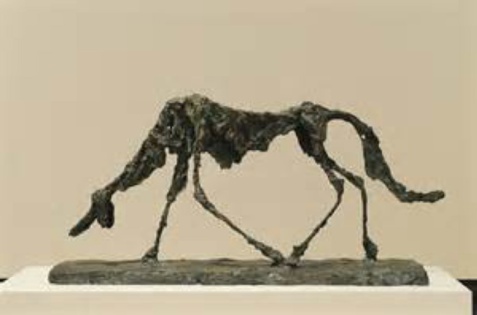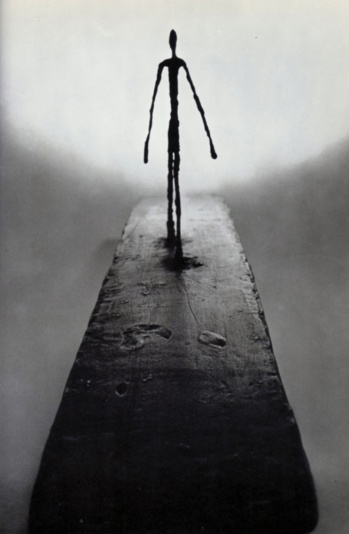“It’s me. One day I saw myself in the street just like that. I was the dog.”[i]

“Le Chien”
1951
Bronze
45 x 98 x 15 cm.
Annette et Alberto Giacometti Foundation, Zurich
“The Dog of Art”
“That dog with daisies for eyes
who flashes forth
flame of his very self at every bark
is the Dog of Art.
Worked in wool, his blind eyes
look inward to caverns and jewels
which they see perfectly,
and his voice
measures forth the treasure
in music sharp and loud,
sharp and bright,
bright flaming barks,
and growling smoky soft, the Dog
of Art turns to the world
the quietness of his eyes.”[ii]
The first time I had heard of the ‘dog of art’ was through this work and from other poets, especially in Baltimore: Jean Rubin and Dr. William Kinter. And later through Edward Hirsch when he visited here in Indianapolis and Chicago. The dog of art was a daemon of sorts: an impish figure who would torture every artist. Pinching a nose here, pulling on an ear there. Tickling or itching one’s body in some way that just could not be ignored, as hard as one might try.
This of course created a tension, a sense that could only be released or satisfied by making something! Denise Levertov and Edward Hirsch are both writers who have shown us this fact. Over and over. The discipline of a writer who continually carves out a vision and a voice. Exactly what Alberto Giacometti would do: not just in sculpture, but he is carving out a space or form in every one of his paintings and drawings as well.

“Alberto Giacometti”
1961
B & W photograph
Henri Cartier-Bresson Foundation, Paris
Whether he was crossing the street near 46 rue Hippolyte-Maindron in Paris to make his way from his studio to a café, or returning to the studio, he was like a dog in the rain, wasn’t he? Caught in a significant moment by Henri Cartier-Bresson on one of these daily trecks, his coat pulled up over his head to protect from the rain, he rarely strayed from his usual patterns.
As the writer James Lord described it, it was in this nearby café where Alberto “…ate what was his ritual lunch: two hard boiled eggs, two slices of cold ham with a piece of bread, two glasses of Beaujolais, and two large cups of coffee.”[iii] He ordered this very same combination for almost 40 years. He worked every day and made his models do the same. Strictly. Religiously.
“…a street during the rain and the figure was me….Me scurrying down the street in the rain.”[iv]

“Walking Quickly under the Rain”
1949
Bronze
32” long
Collection of Mr. and Mrs. Gordon Bunshaft
“The Rain”
“Trying to remember old dreams. A voice. Who came in.
And meanwhile the rain, all day, all evening,
quiet steady sound. Before it grew too dark
I watched the blue iris leaning under the rain,
the flame of the poppies guttered and went out.
A voice. Almost recalled. There have been times
the gods entered. Entered a room, a cave?
A long enclosure where I was, the fourth wall of it
too distant or too dark to see. The birds are silent,
no moths at the lit windows. Only a swaying rosebush
pierces the table’s reflection, raindrops gazing from it.
There have been hands laid on my shoulders.
What has been said to me,
how has my life replied?
The rain, the rain….”[v]
[i] Selz, Peter; Alberto Giacometti; The Museum of Modern Art and Doubleday & Company; New York, New York; 1965; p. 62.
[ii] Levertov, Denise; “The Dog of Art,” Collected Earlier Poems 1940-1960; New Directions Publishing Corporation; New York, New York; 1979; p. 118.
[iii] Lord, James; A Giacometti Portrait; The Museum of Modern Art and Doubleday & Company; New York, New York; 1968; p. 9.
[iv] Selz, Peter; Alberto Giacometti; The Museum of Modern Art and Doubleday & Company; New York, New York; 1965; pp. 56-57. Photo credit: Herbert Matter.
[v] Levertov, Denise; “The Rain,” Poems 1968-1972; New Directions Publishing Corporation; New York, New York; 1987; p. 53.
Very nicely put, Richard!
LikeLike
Thank you so much Jodie.
LikeLike